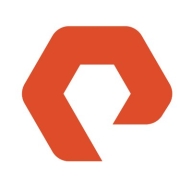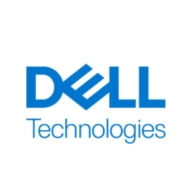


HPE 3PAR StoreServ and Dell PowerMax are both enterprise storage solutions competing in the high-performance storage market. Based on performance indicators, Dell PowerMax seems to have the upper hand due to its advanced NVMe features that enhance speed and efficiency, which are critical for large-scale operations.
Features: HPE 3PAR StoreServ is praised for its ease of use, manageability, and integration with existing infrastructure, making it ideal for cost-sensitive environments. Dell PowerMax is known for its exceptional performance, global cache, and high availability features, excelling in environments requiring high I/O performance.
Room for Improvement: HPE 3PAR StoreServ users suggest improvements in cloud integration flexibility, reporting tools, and feature sets like deduplication and compression. Improvements in customer service efficiency are also desired. For Dell PowerMax, enhancements in deduplication and compression, better management interfaces, and more competitive pricing are areas needing attention.
Ease of Deployment and Customer Service: Both systems are appreciated for straightforward on-premises deployment. HPE 3PAR StoreServ is noted for its reliable support, although language barriers in tech support are occasionally a concern. Dell PowerMax offers comprehensive support with customer service efficiency and cost-effectiveness noted as areas for improvement.
Pricing and ROI: HPE 3PAR StoreServ is competitively priced, offering good value, especially in budget-sensitive projects. Its cost-effectiveness over time is often highlighted. Dell PowerMax involves a high initial investment justified by performance benefits, making it ideal for large-scale deployments, although smaller organizations might find it expensive. Both solutions provide a strong ROI in their respective ideal use cases.
If you wait more than seven years to buy another one, you get a return on your investment.
During a DCDR setup and migration from VMAX to Dell PowerMax, what was planned as a two-day downtime was completed in just three to four hours.
The performance metrics or benchmarks I use to measure success with Dell PowerMax include uptime as well as our response times on our platforms, both of which are exactly where we want them to be, which is five nines and as fast as possible.
My client has seen significant ROI since the install, and when you don't go down, that's an ROI in and of itself.
The return on investment is very good.
Customers always have their issues resolved promptly.
Technical support is good at least through vendors, not directly with the principal.
I would rate Dell PowerMax support as a ten, as I have never had an issue with Dell support as it relates to this product.
ProSupport Next Business Day offers part replacement within four hours for data leaks.
Dell support for Dell PowerMax is exceptional, rating a perfect 10 out of 10.
If we activate the 3PAR call home function, then the remote technician always has access to our StoreServ and provides strong suggestions to improve our 3PAR performance.
It hasn't broken down anytime in the last six to seven years, despite hurricanes, earthquakes, and power outages.
Scalability is not an issue.
Dell PowerMax is good for enterprises, and it also depends on how much workload you're going to bring in on Dell PowerMax in terms of performance and how many users are going to use the database you're hosting.
PowerScale is better suited for AI and overall buzz solution currently.
I would rate the stability of the product at seven out of ten.
These patches can be applied on the fly without requiring software upgrades or system downtime.
I would rate it nine out of ten since there are no required downtimes, even during firmware upgrades.
There has been no downtime with Dell PowerMax; it's been extremely reliable, easy to manage, easy to upgrade, and trustworthy as we've upgraded over the years from one version to another.
HPE 3PAR is a very stable solution from HPE, and people have been using this for more than five years.
My experience with the stability and performance of HPE 3PAR StoreServ involved one crash, which was caused by failing hardware.
One way to improve the product is to add an operational assistant that doesn't depend on VMware.
I would like to see some AI features that would allow arrays to intelligently identify threats or unusual behavior in the data pattern and give an alert.
Storage replication should be essential.
Compared to competitors such as NetApp, which integrates with public cloud hyperscalers (GCP, Azure, AWS), Dell PowerMax lacks in this aspect.
Dell can assist by providing plug-and-play integrated templates that allow customers to drag, drop, modify, and connect with any target system for generating snapshots without logging into the storage directly.
Dell PowerMax NVMe is very reliable storage and cannot experience downtime.
In Pakistan, some parts are not readily available, and we need to import them from Singapore or other countries.
HPE 3PAR StoreServ might be missing certain features available in newer products.
While the prices may be higher than those of other vendors, we see it as a market leader with benefits.
The support can be a bit pricey, but the solution is more cost-effective than anything else out there.
The higher cost compared to other vendors is justified by additional features, vendor-managed upgrades, and superior support services.
It is the best choice for large projects in terms of price and features compared to midrange solutions.
The price is starting from $500,000.
It is expensive, however, when we compare it to the features provided by HPE, the price-to-performance ratio is very good.
Its data compression feature is the best that we have ever seen.
Pure FlashArray X NVMe helps to improve our processing speed.
We are satisfied with the performance as it is significantly faster compared to traditional storage options.
NVMe provides additional fast cache, similar to random access memory (RAM), which improves overall system performance and read/write experience for users.
Dell PowerMax NVMe is very supportive of our operational growth since we require daily performance from our core banking systems and need to facilitate data movement efficiently.
The key benefits of using Dell PowerMax, quantified in terms of saved hours and saved costs, is having one single platform that provides functionality to all of our internal customers.
There is no downtime when we upgrade our 3PAR systems.
I find the HPE 3PAR StoreServ valuable for its ease of use and resilience, which is beneficial.
| Product | Market Share (%) |
|---|---|
| Dell PowerMax | 4.8% |
| HPE 3PAR StoreServ | 3.1% |
| Pure FlashArray X NVMe | 1.4% |
| Other | 90.7% |



| Company Size | Count |
|---|---|
| Small Business | 15 |
| Midsize Enterprise | 11 |
| Large Enterprise | 12 |
| Company Size | Count |
|---|---|
| Small Business | 17 |
| Midsize Enterprise | 15 |
| Large Enterprise | 55 |
| Company Size | Count |
|---|---|
| Small Business | 72 |
| Midsize Enterprise | 74 |
| Large Enterprise | 170 |
Pure Storage FlashArray//X is the world’s first enterprise-class, all-NVMe flash storage array. It represents a new class of storage – shared accelerated storage, which is a term coined by Gartner – that delivers major breakthroughs in performance, simplicity, and consolidation.
PowerMax leads in mission-critical enterprise storage with advanced architecture and AI-driven automation, ensuring secure and efficient IT optimization. Its multi-node NVMe scale-out framework delivers unmatched performance and consolidation, backed by Dell’s Future-Proof Program.
PowerMax is renowned for its robust reliability, performance, and efficient data reduction capabilities. Users benefit from its NVMe architecture, aiding significant scalability and cost efficiency through effective deduplication and compression. Unisphere simplifies management, while CloudIQ provides enhanced monitoring. With high availability and strong IOPS capabilities, PowerMax effectively manages demanding workloads and ensures seamless operations. Its compact design and increased storage capacity enhance user experience, particularly with easy maintenance and robust performance.
What are the key features of PowerMax?Dell PowerMax is predominantly employed in mission-critical applications such as SQL, Oracle databases, ERP systems, and high transactional environments. Healthcare, finance, and e-commerce sectors leverage its high performance, scalability, and NVMe technology for low latency and redundancy. It is adept in storage consolidation, data analytics, and disaster recovery.
HPE 3PAR StoreServ is an AI-driven storage solution that prevents issues before they occur by learning and adjusting in real time. The solution offers a tier-1 all-flash foundation for mission-critical workloads. HPE 3PAR StoreServ was designed with more than 3M IOPS and consistent sub-ms latency. It aims to transform midrange and enterprise deployments with solutions that scale from a few TBs to more than 20PBs. In addition, the solution is built to modernize data centers and is made to handle unpredictable workloads effortlessly. By implementing HPE 3PAR StoreServ, you gain automated and rapid provisioning, hardware-accelerated deduplication and compression, and a multi-tenant design.
HPE 3PAR StoreServ Features
HPE 3PAR StoreServ has many valuable key features. Some of the most useful ones include:
HPE 3PAR StoreServ Benefits
There are many benefits to implementing HPE 3PAR StoreServ. Some of the biggest advantages the solution offers include:
Reviews from Real Users
Below are some reviews and helpful feedback written by PeerSpot users currently using the HPE 3PAR StoreServ solution.
A SAN Consultant at a tech services company says, “One of the features that I like the most is the data replication element. The reason I like it is due to the fact that it's pretty clean on replicating data over to a second site. The product stands on its own in heavy enterprise environments. It's easy to make changes without affecting the environment. The solution is very easy to use. The product is very robust and offers very good performance.”
A Storage Manager at a financial services firm mentions, "There are a lot of screens for easy management where you can change some settings. But after a few years, the important settings were better after an upgrade, and all the vendors have other ways to upgrade their systems."
A Senior IT Infrastructure & Data Center Operation Engineer at Ministry of Communications and Information Technology (MCIT) comments, “The adaptive optimization is the biggest feature in 3PAR. 3PAR is very usable with thin volume because it detects zeros while writing. Every time I tell the hypervisor to make the full provisioning, it makes the volume as simple provisioning in 3PAR, not full provisioning.”
We monitor all All-Flash Storage reviews to prevent fraudulent reviews and keep review quality high. We do not post reviews by company employees or direct competitors. We validate each review for authenticity via cross-reference with LinkedIn, and personal follow-up with the reviewer when necessary.